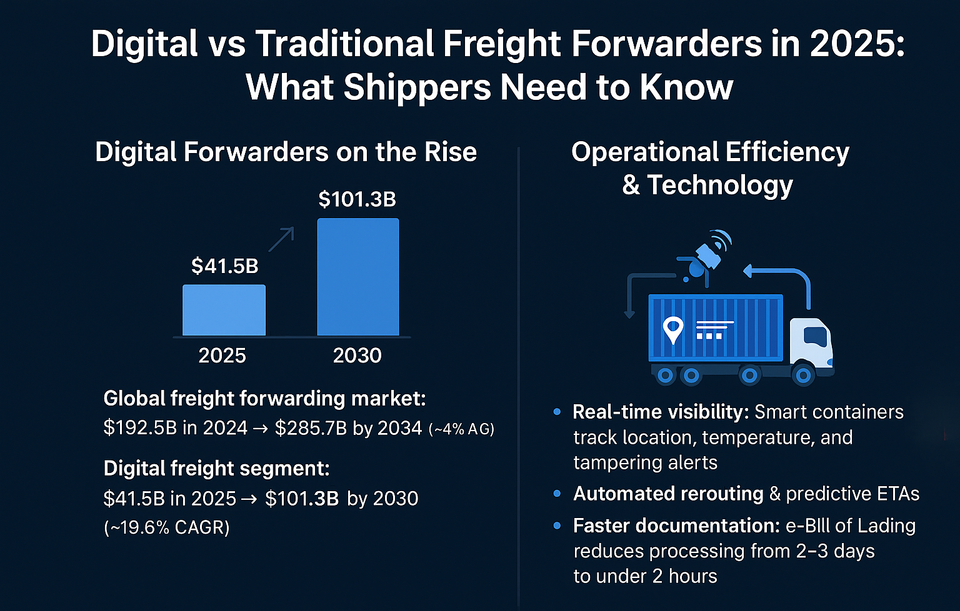Digital vs Traditional Freight Forwarders in 2025: What Shippers Need to Know

The logistics landscape is evolving rapidly. Traditional freight forwarders, long trusted for their expertise and networks, are now facing a new wave of tech-driven digital forwarders.
While legacy players still handle most cargo today, digital platforms are growing fast — offering speed, transparency, and scalability. Exporters, importers, and logistics professionals need to understand the key differences and trends shaping 2025.
Digital Forwarders on the Rise
The numbers tell a story of rapid growth:
- Global freight forwarding market: $192.5B in 2024 → $285.7B by 2034 (~4% CAGR)
- Digital freight segment: $41.5B in 2025 → $101.3B by 2030 (~19.6% CAGR)
- Asia-Pacific growth: India’s digital logistics is nascent ($1.8B in 2024) but projected to reach $12B by 2035 (~19% CAGR)
Digital forwarders are capturing a fast-growing slice of trade by offering real-time tracking, automation, and scalable operations.
Traditional forwarders still dominate overall volume, but their growth is slowing compared to the tech-driven newcomers.
Operational Efficiency & Technology
Digital forwarders leverage AI, IoT, and cloud-based TMS to make shipments faster and more predictable.
Key benefits include:
- Real-time visibility: Smart containers track location, temperature, and tampering alerts
- Automated rerouting & predictive ETAs
- Faster documentation: e-Bill of Lading reduces processing time from 2–3 days to under 2 hours
For example, MSC’s “WAVE” e-BL system in India saved $138,000 in demurrage across 230 containers — proving digital efficiency at scale.
Traditional forwarders still excel in handling irregular cargo, complex customs, and local regulations.
They may be slower, but their hands-on expertise and human networks remain unmatched for complex shipments.
Cost Structures & Scalability
Digital Forwarders
- Lower variable costs and minimal paperwork
- Easy scalability via cloud platforms
- Advanced analytics for predictive operations
Traditional Forwarders
- Higher fixed costs (offices, staff, agents)
- Limited scalability without major investment
- Strong human network for complex shipments and emergencies
While digital models are faster and scalable, some Indian startups like Freightwalla have failed despite funding — highlighting the risk of rapid growth without sustainable margins.
Customer Experience: Speed vs Personalization
Digital forwarders offer 24/7 online booking, tracking, and automated alerts, ideal for standard shipments.
Transparency and speed are their main selling points.
However, limited human interaction can frustrate clients handling complex or urgent cargo.
Traditional forwarders provide personalized account management, hands-on guidance, and reliable support.
They are slower — but trusted for high-value or intricate shipments.
Trend: The hybrid model — combining digital speed and visibility with human expertise — is emerging as the best practice for shippers in 2025.
Key Players in 2025
Global
- Traditional: Kuehne+Nagel, DHL, DB Schenker, DSV
- Digital: Flexport, Forto, Freightos, Zencargo
India
- Traditional: Allcargo, Mahindra Logistics, Gati, Blue Dart/DHL
- Digital/Niche: Freight Tiger, BlackBuck, Delhivery, XpressBees
Many traditional forwarders are now launching digital portals and TMS solutions, creating hybrid models to remain competitive.
Regulatory & Infrastructure Drivers
India
- National Logistics Portal (NLP)
- e-BL mandates
- Sagarmala port upgrades
- Dedicated Freight Corridors
Global
- IMO 2023 regulations
- EU carbon rules
- Digital documentation standards
Forwarders that adopt technology quickly gain efficiency and compliance advantages, while laggards face delays, higher costs, and growing competitive pressure.
Conclusion: The Future is Hybrid
The freight forwarding industry is moving toward hybrid models.
Traditional players are embedding digital tools, while digital forwarders are expanding into consulting, customs, and value-added services.
Shippers who embrace this balance will enjoy speed, transparency, and trusted expertise.
Those ignoring digital adoption risk are being left behind.
Key Takeaways
- Digital forwarders: Speed, automation, real-time visibility
- Traditional forwarders: Expertise, trust, complex cargo handling
- Hybrid solutions: The future of logistics
- Regulatory & infrastructure shifts: Favor digitization
- Smart shippers: Integrate technology without losing human guidance
